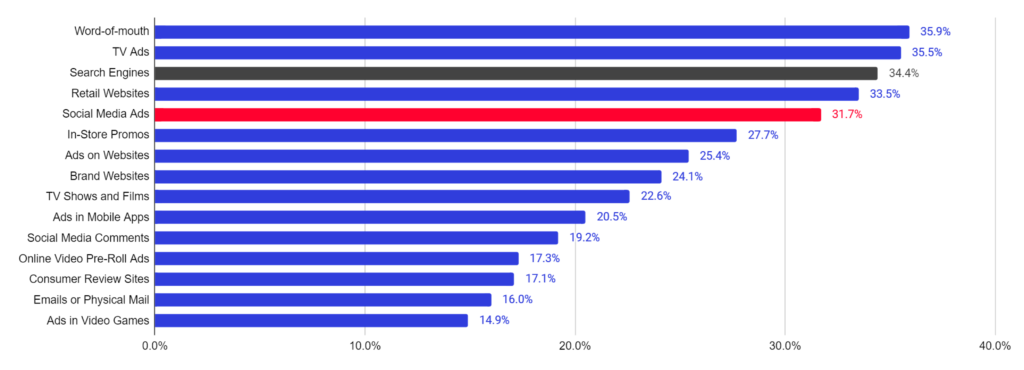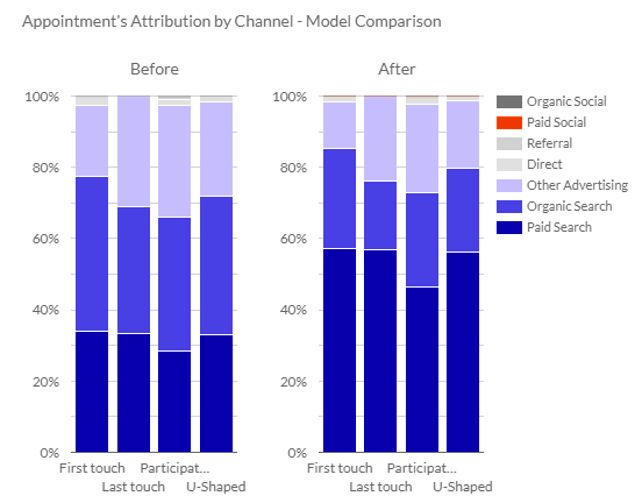Social media is undeniably part of the modern patient journey. Reports show that social media usage is only increasing; over two out of every three people in the US now use social media. And advertising on social media is increasing as well, for good reason.
As it gets more difficult to dominate bottom-of-funnel searches—due to both competition and changes from Google itself—upper funnel investment becomes essential. Although it’s more difficult than ever to reach a customer searching for healthcare, reaching a customer searching for you specifically is a much more appealing proposition. You don’t want them going to the search engine results page without any familiarity with your brand; they’ll simply choose the first option. For that to happen, they need to already be familiar with your brand.

With Twitter on a steep decline and TikTok’s fate apparently sealed, Meta’s importance has only grown. But figuring out how to get the most out of Meta can be tricky, especially with Meta’s recent groundbreaking announcement of changes to healthcare advertising.
Here’s a brief explanation of what Meta has changed and a truckload of tips for how to supercharge your healthcare marketing on Meta in 2025.
Meta’s New Healthcare Advertising Restrictions
Meta announced that starting in January 2025, all healthcare businesses will have their data sources categorized by Meta into one of two categories:
- Fully Restricted Properties: No website conversion campaigns will be allowed (e.g., condition-specific domains like treatmigraines.com).
- Mid-Restricted Properties: Lower-funnel optimizations (e.g., broader domains like hospital websites) will be restricted.
The new rules impact bottom-of-funnel campaigns, where Pixel and CAPI audiences will be restricted, and form submissions can no longer be used for performance optimization.
To keep your BOF campaigns functioning, marketers are advised to get a BAA signed with a privacy platform or at least mimic some of their best privacy practices, such as using neutrally named events and avoiding pixels.
Thankfully, there are still many ways to make good use of advertising on Meta:
Target 3rd Party Audiences
3rd party data sources offer a great opportunity for advanced targeting and audience building. A variety of audience vendors exist, such as Illumin, Purple Labs, Definitive, Magenta, Foursquare, StackAdapt, etc., and they offer audience options that allow you to target based on:
- Insurance Payor Network
- Household Income
- Diagnosis
- Medication
- App Usage
- Competitor Conquesting
- Predictive Audiences
All of these factors allow you to increase your lead quality by reaching the right patients.
Don’t forget that you can also geofence with layered audiences. In addition to directly targeting a 3P audience with a certain insurer like Blue Cross Blue Shield (BCBS), you can use StackAdapt to geofence around office buildings where you’re likely to find employees who have BCBS coverage.
Leverage The Halo Effect
One of the more underappreciated benefits of social media advertising is the halo effect. Establishing a positive impression of your brand continues to influence your audience long after they log off of social media. Experiments (including our own) have shown that paid social campaigns provide a tangible boost to branded search volume.

In short, a lot of the value of paid social advertising won’t necessarily come from direct conversions. The nature of upper-funnel advertising means that the payoff presents itself at the bottom funnel.
Use Better Attribution
To capture the benefits that advertising on social media provides for your brand, it’s important to have sophisticated reporting that includes proper attribution:
View-Through Attribution
View-Through Attribution ensures that you capture the true effect that paid social media has on your lead volume. If you only use click-thru attribution, you’ll end up ignoring all of the users who searched for you later because they first saw you on social media.
Cross-Channel Attribution
The modern patient journey has many touchpoints along the way, and understanding and crediting those touchpoints properly is the only way to properly assign credit for new appointments to the proper channels.
Too many organizations discount paid social when the direct conversions aren’t there. However, paid social media may still be driving a bump in appointments and increasing search traffic, which proper attribution can help capture. This is crucial for accurate reporting that includes the real data on where your advertising is driving a good ROI.

Test with Hyper-Segmentation, Consolidate Audiences Long-Term
Hyper-segmentation is a valuable tool for the testing phase, where breaking down audiences into tiny segments allows you to micro-target various combinations to better understand the audience you should be targeting and how best to target them.
However, once you’ve figured out your audience, you want to consolidate audiences as much as possible. Not only will this simplify your account, but consolidating your audience will help ensure that you’re getting sufficient volume to feed the algorithm useful data. Over-segmentation often results in campaigns struggling to achieve sufficient conversions for effective optimization.
You want to limit the number of ad sets you create to ensure you can reach at least 50 weekly conversions per ad set because that’s the volume you need for the algorithms to properly optimize for events.
Note that you can no longer optimize for website conversions directly under Meta’s new rules. One approach to overcome this restriction is to use neutrally-named trackable events (like a button click tracked as “Event C17”) just before the conversion. This will allow you to still feed the algorithm user behavior data.
Diversify Your Creative
Audiences will quickly tire of seeing the exact same ad, so it’s important to have variety within your ad sets. It’s far better to run two ad sets with seven creatives each than seven ad sets with only two creatives each.
As a rule of thumb, always have at least three creatives running per ad set. This will help keep audiences engaged and keep CPM down to a reasonable level.
Optimize Event Match Rate
With Meta’s latest restrictions, event-tracking has become more regulated than ever. All the more reason to use a customer data platform (CDP) or privacy platform like Freshpaint, which will make it easier to pass the right information along while staying on the right side of the privacy restrictions.
Presuming you’re using a platform that properly anonymizes events and protects PHI, you should still be able to optimize for events, and the key to doing that on Meta is the Event Match Rate.
Match Rate is Facebook’s measurement of how well the user data sent from your end matches the user data on Meta’s end on a scale of 1-10. Ideally, you want to be optimizing for events with at least 7 match rate points, which will help you reach a much lower CPA than you’d see from events with only a 5 match rate.
Just keep in mind that Meta’s rules on this are still very new (starting January 2025), and details may be subject to change.
Start With a Broader Audience Size
Reaching the right users and gathering enough conversions requires a certain audience size. While it can be tempting to keep criteria very narrow, keep in mind that your initial audience in the audience tool will be narrowed significantly by Geofencing. In order to be effective, your initial audience list should always be at least 100k.
If your list is starting below 100k, it will probably shrink too small after Geofencing. When you have too small of an audience, you’ll struggle to gain the conversion signals needed for effective optimization. So you’d be better off expanding your criteria.
Use Audience-Specific Messaging
Audience-specific messaging in social assets drives 45% more conversions than generic ads, according to Facebook Ads Data. People want something that speaks to them and will tune out generic ads. Good creative messaging is a way for your brand to stand out by talking to your audience directly rather than just offering boilerplate ads.
Qualify Patients with Conditional Lead Forms
A big advantage of advertising with Meta is the ability to use Facebook’s enhanced lead forms. These forms include conditional logic, which lets you show users different messages in the form and link to off-app pages based on how they answer a question. This lets you filter out unqualified candidates by redirecting them to informational pages, ensuring that only qualified patients reach the final stage of lead form submission.
So far, it appears that lead forms should remain unaffected by Meta’s new restrictions.
Use A/B Testing To Establish Creative Guidelines
No matter how good your paid social strategy is, you can’t know what works until you test it. A/B testing is one of the most effective methods for determining what works. You can run the same ad with blue and red backgrounds to see which color your audience prefers. Or different creative styles. Once you see your audience’s preferences, use that as guidelines for future creative.
A/B testing works for copy as well and will help you determine what types of headlines and language work best for your audience. This can then serve as a guidepost for future ads in that campaign.

